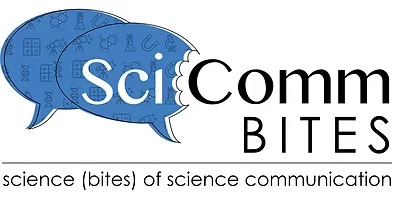Oohing and Aahing: Establishing Awe as a Learned Behavior
Paper Title: The construction of awe in science communication
Author(s) and Year: Daniel Silva Luna and Jesse M. Bering; 2021
Journal: Public Understanding of Science (open access [link])
TL;DR: Awe has traditionally been used as a tool by science communicators to engage their audience; however, the authors propose that awe is a learned emotion and a product of an individual’s socialization. This implies that awe does not yield the same results with diverse audiences.
Why I chose this paper: I was taught that the first step to take when preparing myself for a presentation or talk is to establish who my audience is: where are they from, where do they work, what’s their domain of knowledge, and what might they expect from me? All of this information helps me tailor my talk to ensure my goal is achieved by the end. In the past, I’ve relied on a mix of trying to inspire intrigue and curiosity, or injecting my presentation with some humor to keep my audience engaged. Because of my past experiences, the title of this publication by Silva Luna and Bering caught my attention.
Engaging your audience is an important part of science communication, and there are various ways their attention can be captured: eye-catching images, humor, and even using negativity to engage the audience. Traditionally, it can be assumed that inspiring awe in your audience makes them interested and receptive, while also increasing willingness to accept the knowledge being transmitted. The authors of this article propose that this ‘traditional’ view of awe as an emotion is not appropriate because it does not allow for diverse experiences and motivations related to awe-like emotions. Silva Luna and Bering propose that there is not a universal response (i.e., interest and curiosity) when individuals feel awed. They instead posit that viewing awe under a ‘constructionist’ view (i.e., as a learned emotion with diverse responses to it) is more suitable and that communicators can use this to their benefit and enhance their work.
The Background
Awe as an Innate Response? Not Anymore
Silva Luna and Bering argue that a “broader conception” of awe is much needed in the field of Science Communication. Under the classical view, there is the assumption that awe is an evolutionary adaptation that creates curiosity, regardless of the individual’s views or past experiences.
The authors establish how historically, science communicators have relied on eliciting awe and similar emotions from their audience (think Carl Sagan’s Cosmos) in order to promote, increase, and maintain engagement. This view also assumes that the function of awe is to promote curiosity and interest and that everyone reacts the same way to it. Under the classical view, most people would feel subsequent curiosity when perceiving or thinking of “awesome stimuli,” like the view of Earth from the Moon or how motor proteins like kinesin participate in cell transport. The authors propose that the problem with relying on the ‘classical’ view is that the effects of awe, awe-like emotions, and “awesome stimuli” are not universal.
The Methods
Advocating for a Constructionist View
Reevaluating awe using a constructionist view, awe can be considered an acquired and culture-specific emotion. What does this mean? Constructionism is a theory in the Social Sciences which proposes that knowledge is not based on objective or unbiased observation of the world. Instead, knowledge is based on a historical and cultural context and is supported by interactions with the individual’s environment. It also postulates that knowledge goes hand-in-hand with social processes (e.g., socialization and language). Basically, no assumptions can or should be made when studying or perceiving processes related to human nature.
The Results
The authors pose a handful of ideas regarding awe, supporting its study and use under constructivism. These are highlighted below:
Awe Is Culturally Learned
Silva Luna and Bering state that, “People learn and practice emotions in the cultures they navigate through their lifetime.” A culture can be seen as the representation of a community and the individuals that are part of it; this holds true for the scientific community as well. To demonstrate this point, the authors summarize a study by Smith et al. that examined the responses of two focus groups to astronomical images (like the one featured at the top of this “bite”!). One focus group was composed of professional astronomers, while the other included astronomy enthusiasts. Astronomers who were frequently exposed to this type of magnificent imagery had more data-driven and technical responses to the pictures. Meanwhile, the enthusiasts expressed “awe and wonder” when viewing the same pictures.
Awe Has Multiple Forms and Functions
There is not a “one-to-one correspondence” between awe and its function, which means it can have a variety of effects depending on the context and an individual’s past experiences. The products of awe can include: curiosity, frustration, boredom, anger, or sadness. The authors use anger as an example. When anger is studied under the ‘classical’ view, it might solely be considered as a universally negative emotion with negative repercussions. Under the ‘constructionist’ view, the cultural context is considered. In some cultures that value individualism, the effects of anger are related to aggression. In other cultures that value egalitarianism (i.e., equality), individuals can experience anger, and the effect may be experiencing self-blame or exercising restraint.
Previous Knowledge Affects How Awe Manifests
Experiences related to the emotion of awe are based on past encounters with this emotion. The authors consider Humm et al.’s paper, which studied how persons from underserved communities can feel negatively toward science due to past interactions that left them feeling excluded or detached. In the past, individuals from these communities may not have been encouraged to learn and investigate after feeling awe and curiosity. Science communication has historically excluded certain communities due to social inequality, sexism, and racism. It is no surprise that people from minoritized groups with unpleasant experiences related to science and awe might not feel curious or encouraged to learn more when experiencing this emotion.
The Impact
Under a Constructionist Lens, It’s All About Context!
How does this knowledge and perception of awe under the ‘constructionist’ view help science communicators? In the end, it is all about context. Perceiving awe as a learned behavior and a product of culture and socialization can allow researchers to better tailor their content for specific communities. Science communicators need to broaden their beliefs and expectations of their audience and to cultivate cultural sensitivity.
In the end, every individual is different and we cannot assume that everyone’s motivations and needs are the same. Next time you are preparing content and are planning to rely on aweing your audience to engage them, thoroughly consider the individual (their diverse wants, needs, and any preconceived notions you might have about them). Think about how their responses to feeling awe may vary, and then, look at your content again with a critical eye.
—
Written by Mariella A. Mestres-Villanueva
Edited by Diego Ramírez Matín del Campo and Sarah Ferguson
Featured image credit: Nick Wright, Astronomy Picture of the Day

